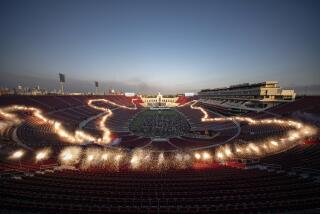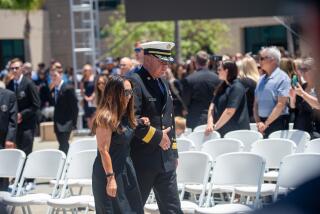Explosion Kills 4, Injures 25 at L.A. Toy Factory
- Share via
Four workers were killed and at least 25 others were injured Wednesday when a machine apparently exploded with a powerful blast at a toy factory in downtown Los Angeles, fire officials said.
The blast on the factory floor at the Imperial Toy Corp. showered debris and glass window fragments across the 2000 block of East 7th Street and blew a hole through the roof of the building with a boom that could be heard for blocks.
The factory, at the southwest corner of 7th Street and Santa Fe Avenue, makes explosive caps for toy guns, as well as jump ropes, makeup kits and soap bubble toys.
Los Angeles Fire Department Fire Capt. Steve Ruda, who inspected the scene after the blast, said the machine at the explosion site was used to wrap plastic around the paper caps.
The exact cause of the explosion was not immediately known. Los Angeles Fire Department Capt. Steve Ruda, who inspected the scene after the blast, said the explosion apparently occurred at or near a machine used to wrap plastic around the paper caps.
Eyewitnesses said the 3:20 p.m. explosion sent screaming workers into the street.
“I looked outside and saw people running out. People were running for their lives,” said Jose Valverde, 31, who works in a warehouse about a block away. “I asked them, ‘Que pasa, que pasa?’ and they would say ‘explosion.’ ”
Identities of the dead were not immediately available.
The blast occurred on the second floor of the 1913 building in the heart of the downtown toy district. The structure was built by Henry Ford to serve as his first California auto plant.
The force of the blast blew the panes out of five 10-by-20-foot windows along Santa Fe Avenue, leaving the block littered with vertical blinds and fragments of the factory roof.
Fire engines, ambulances, television news trucks, helicopters and the LAPD bomb squad converged on the normally quiet industrial area. Paramedics set up triage areas on a nearby sidewalk.
Four of the injured workers, all women, were taken to two hospitals, White Memorial Hospital in Boyle Heights and County-USC Medical Center. One died and one was released. Two surviving women remained hospitalized late Wednesday, one in critical condition.
The machine, about the size and shape of a home refrigerator, showed obvious blast damage, Ruda said. A scorched area near the machine may be where the fire broke out, he said.
Ruda said it was not known whether the fire preceded the blast or vice versa, but that several spent fire extinguishers found near the charred area suggest that employees were trying to put out a blaze when the blast occurred.
Investigators had not determined where the employees who were killed and seriously injured were working when the blast occurred. Ruda said about 25 employees were in the general area of the blast. About 150 people were working in the building.
At White Memorial, an unidentified 20-year-old woman who is three months pregnant was treated and released with minor injuries. Guillermina Guadron, 55, a 10-year employee from Los Angeles, was in fair condition with second-degree burns, hospital spokesman Terry Kanakri said.
Another seriously injured woman was breathing with the aid of a respirator at County-USC Medical Center, hospital officials said.
Relatives of Guadron said she told them she was packaging toys not far from the sealing machine when the explosion threw her to the floor.
Guadron’s son Sergio, 16, said his mother told him she saw flames after the explosion, but that there was no fire before the blast.
The California Division of Occupational Safety and Health dispatched personnel to the site late Wednesday and launched an investigation, a step required by law in cases of death or serious industry in the workplace, said Mark A. Carleson, deputy chief of Cal/OSHA.
“At this point, we’re going to try to get a handle on what happened,” Carleson said. “It could have been a very unusual set of circumstances not endemic to that type of work. Then again, it could be an endemic-type problem. We don’t know yet.”
Depending on what inspectors find, Carleson said, the probe could trigger a broader inquiry into the toy industry. “To my knowledge, we have not spent a lot of time in toy factories,” Carleson said.
Carleson did not know if inspectors had ever visited the plant. Such inspections are typically triggered by complaints, Carleson added, and authorities late Wednesday said they had not had time to check their records.
Investigators from the federal Bureau of Alcohol, Tobacco and Firearms and the Los Angeles Police and Fire departments were at the scene. Los Angeles Fire Chief William Bamattre said during a news conference that there was no evidence of a crime.
Workers at companies near the factory said they were literally shaken by the explosion.
Dan Sundstrom, 39, who works at a film studio across Santa Fe Avenue from the toy factory, described the blast as “a deep percussion--the biggest explosion I’ve ever heard--followed by the sound of material raining down on the street.”
The blast was so strong, Sundstrom said, that “you could feel it hit your body. There were no visible flames but you could see some smoke and you could see daylight through the [blasted out] roof of the building. Three or four people came running out screaming, yelling for ambulances. They said there were a lot of people hurt inside.”
Sundstrom said those emerging from the plant were drenched with water, which he assumed came from fire sprinklers.
Several people who were near the factory at the time of the explosion said they mistook it for an earthquake.
Imperial was founded in 1969 by Fred Kort, a survivor of the Treblinka Nazi death camp. It began with four employees and now reportedly employs more than 200. The company reported annual revenues of over $50 million, according to documents the company filed last year in response to a copyright infringement lawsuit.
Kort was on his way back from Hong Kong and not available for comment Wednesday, according to Cathy Kort, his daughter-in-law.
Kort said her husband, David, one of the company’s owners, was working in a windowless office in another part of the plant when the explosion occurred. She said he immediately assumed the blast was an earthquake and telephoned her at home in Granada Hills to see if she was all right.
Cardinal Roger M. Mahony was among those who went to the scene. “We’re very anxious to see if anyone needs help,” Mahony said. “We’re here if someone wants us to pray for them.”
Mayor Richard Riordan, who was also at the scene Wednesday evening, said his “thoughts are with the families of the workers, particularly with the families of the workers who were killed,” and that he was on his way to meet with survivors and victim’s families.
One of the largest toy companies in the toy district, Imperial is one of only a few manufacturers in the area, according to Charles Woo, head of Mega Toys, a neighboring toy company. Most of the “Toy Town” companies import toys from Asia for sale in the United States, Mexico and South America.
Since the 1980s, the Los Angeles toy industry has blossomed into a collection of more than 500 companies, employing more than 5,000 people, according to industry analysts.
Toy industry observers have estimated that more than 60% of the toys sold in U.S. retail stores are distributed from Los Angeles. Wednesday’s tragedy was an echo of the worst industrial disaster in Los Angeles’ history, which occurred half a mile away a half-century ago.
On Feb. 20, 1947, a factory explosion killed 17, injured 150 and ripped apart a four-block area in the downtown manufacturing district.
At 9:45 a.m. that day, a vicious chemical blast at the O’Connor Electro-Plating Co. destroyed or damaged 116 buildings and opened a crater 22 feet wide and 6 feet deep. The blast shattered windows across a square-mile area and was felt as far away as Long Beach and the San Fernando Valley.
*
Contributing to this report were Times staff writers Valerie Burgher, Peter Y. Hong, Denise Gellene, Brett Johnson, Patrick McDonnell and Cecilia Rasmussen.
More to Read
Sign up for Essential California
The most important California stories and recommendations in your inbox every morning.
You may occasionally receive promotional content from the Los Angeles Times.










